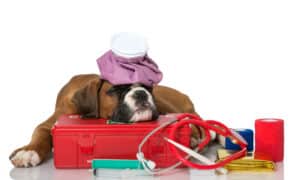“This post contains affiliate links, and I will be compensated if you make a purchase after clicking on my links.”
Hopefully you won’t need this information, but if you should, here’s some tips on how to bandage your dog correctly. When your dog gets an injury, giving him a safe, clean and properly applied bandage can help him recover quickly. It also helps prevent possible infection or other complications which can often lead to expensive surgeries and medications. A bandage stops bleeding and reduces your dog’s pain and suffering. It can also keep away germs and bacteria from entering your dog’s wound or cut.
There should always be a first aid kit available, whether you are at home or spending time with your buddy outside in a trip or vacation. The most important (and must-haves) for your doggy first aid kit are: antiseptic, sterile pads, adhesive bandages or tape, rolls of cotton and gauze, and household sticky tape. Aside from that, one should also be ready to replace any materials that have run out, or create makeshift bandages for emergency purposes. Of course if you have one, a well-stocked “human” first aid kit will usually suffice for Fido, too, so a separate “doggy” kit probably won’t be necessary.
How To Bandage Your Dog Correctly
In order to make a good bandage for your dog, follow these easy steps:
- First, you have to clean and disinfect the wound of your dog.
- Next, put an absorbent pad on the wound. The pad should be sterilized and nonstick.
- Over the pad, wrap a gauze bandage with one-third of the bandage being exposed on each wrap. Also, wrap some of your dog’s fur on both sides of the pad.
- Next, wrap a layer of adhesive tape / bandage over the gauge bandage.
- Test the right pressure by placing two fingers under the bandaging, and then remove them. Keep wrapping the adhesive material over the sides of the gauze that is underlying.
- Keep the pressure balanced by placing and removing your fingers from time to time as you cover the gauze bandaging with adhesive tape.
- Use a strip of sticky tape to connect the fur and the bandage. This will help in keeping the bandage secured from slipping.
Dogs can experience different kinds of injuries, and at times, the above steps aren’t enough. Here are additional things that you need to do for extra care depending on the kind of injury:
- For leg wounds, wrap roll cotton over the gauze pad, then wrap stretch gauze, and finish with adhesive tape or bandage.
- For tail wounds, do the above mentioned steps, but use long materials and secure the bandage on your dog’s tail in case it might fall off from wagging.
- For torso wounds, wrap a towel around the torso, or a pillow case. Use pins on the side (opposite of the wound) to secure the bandage.
Alternative materials you can use, in case you do not have the above materials, are clean sheets, towel strips, and even old clean clothing cut to fit your dog’s size. Household paper products can be used for substitute pads, and they can have ointment applied to them before placing them on the wound.
In addition, keep your dog’s bandage secured at all times, and make sure the bandage is just right – not too loose or too tight for your buddy. Keep them clean as well, and if they get dirty, change them immediately.
Be sure to comfort and praise the dog liberally during the bandaging process, so he doesn’t come to see it as an ordeal to be dreaded.
One word of caution, as explained in an article on the PetPlace.com website:
Bandages and splints do not help fractures of the humerus (upper arm bone) or femur (thigh bone). They can even cause more damage. If you suspect that your pet has a fractured upper thigh bone or upper arm bone, do not use a bandage or splint. Try to keep your pet as quiet and confined as possible and contact your veterinarian.
Personally, if I suspect my dog has a broken bone anywhere, not just in the locations explained above, I let my vet handle it. Then I can take care of proper bandaging, knowing the dog will heal properly.
If the occasion arises, remember the above tips for how to bandage your dog correctly.
Have you ever had to go through this process with your dog?
























Stephanie Santoro, CVT
says:There are some problems with this article.
first- what should you ‘disinfect’ the wound with? Chlorhexidine? Betadine? Can pet owners get chlorhex scrub over the counter? (In my experience: no, but who knows. Regardless, you can’t expect laypeople to automatically know what to use, and you can’t always get this stuff at Walgreens.)
2- a “sterilized” pad? How do you presume they sterilize it, in their autoclave at home?
3-gauze should never go next. Cast padding should go next.
4-adhesive tape over gauze?
5-a towel for torso wounds? If your pet has a wound that large, it NEEDS TO SEE A VET.
6-“household sticky tape?” What? You would never use duct tape or masking tape (or anything but bandage material) on a pet’s skin or fur.
I want to know your credentials. Your instructions are sub-par, and I think you are doing a disservice to pets and pet owners that need actual medical help. Owners- Please call your vet before doing any of this.
To the editor: I suggest that you take medical advice columns seriously, and have them reviewed by Veterinarians or credentialed Veterinary Technicians.
Marh
says:This website is so great for those of us who often panic when our doggo gets hurt. Provides the best sources of information.
[…] Keep a first-aid kit on hand. This kit should include: plain 25 mg Benadryl tablets, gauze pad, dog medical tape, and iodine disinfectant. Plain Benadryl tablets are great to have on hand for days when your dog is extra itchy. Ask your vet if Benadryl is safe to use with your dog’s other medicines and how much your particular dog needs before administering it. Gauze pad, medical tape, and iodine are convenient to have if your Jack Russell breaks the skin from scratching or biting its itches. Instructions for bandaging a dog can be found here. […]
Be a parent of your dog instead of just be a care taker at the times when your dog need your actual help. Circumstances can be varried but dog cannot be. Be calm when your dog is seriously injurred. This injury can be made bigger if not treated immediately and focussed.
joy
says:One thing worries me. HOW PAINFUL IS IT TO REMOVE STICKING TAPE FROM THE DOG'S TUMMY AFTER STERILIZATION??? is it less painful if you wet it first?
Robin
says:Thank you for the pillowcase towel idea!! I didn’t want her to have to wear a cone from the vet…dogs just really dislike those! I ended up using an old T-Shirt, and it worked perfectly on her torso. Kudos!!
It’s amazing to pay a quick visit this website
and reading the views of alll mates on the topic of this paragraph,while I am also keen of getting familiarity.
Hi, I do think your web site could be having
browser compatibility issues. When I take a look at your site in
Safari, it looks fine however, if opening in Internet Explorer, it’s got some overlapping issues.
I merely wanted to provide you with a quick heads
up! Other than that, wonderful site!
Talon Lakes
says:Thank you so so so much, my dog has been bitting his leg, so thank you for putting this out there. Thank you again.